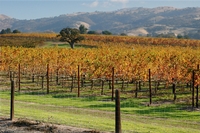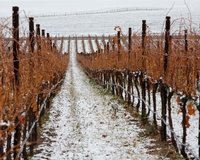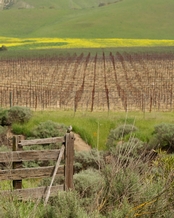It’s amazing how easy it is, when talking about top California wine regions, to forget about Livermore Valley.
It’s not like Livermore Valley wine is in airport duty-free shops — oh wait, there’s Wente Chardonnay, and I think I see a bottle of Concannon Petite Sirah. OK, well it’s not like Livermore wine wins major awards. Except best red wine overall out of 5500 total wines entered at this year’s San Francisco Chronicle Wine Competition (a McGrail Cabernet Sauvignon).
I could go on: The first major award won by ANY California wine was a Livermore white at the 1889 Paris Exposition. This is the 100th anniversary of the planting of the Wente clone of Chardonnay, the most widely planted clone in the state.
And yet, here we are. What was the last Livermore Valley wine you had? Or more significantly, read about?
I couldn’t find a Wine Spectator article about Livermore from the last decade, since Concannon was sold. And I went out to Livermore in  March to write about the winery that won the Chronicle’s competition for my blog because the newspaper couldn’t be bothered to do so.
March to write about the winery that won the Chronicle’s competition for my blog because the newspaper couldn’t be bothered to do so.
I’m often just as guilty. Enjoying a bottle of Fenestra Livermore Valley Semonnay 2010 ($16), a Chardonnay-Semillon blend, I realized that I’ve liked every vintage I’ve had, that it represents the Livermore terroir, and that it’s great value. And yet, it’s from Livermore, and I hadn’t thought of it since the last time I had it.
You’d think Livermore is an out-of-the-way backwater instead of a suburb in the San Francisco Bay Area, reachable from just about anywhere in the city in less than an hour. You’d think the climate or soils were bad, but the weather is very similar to the center of Napa Valley, and the gravelly soils are just fine.
The main reason for the obscurity is that, other than Wente and Concannon, most of the wineries are content to sell their wines in their tasting rooms to the half-million annual visitors, most of whom live in the East Bay.
Even the Wentes, the most tireless promoters of the region, backed down on promoting Livermore with their joint project with the Food Network. The Entwine wines (silly me, I first thought it was wine for ents, like in Lord of the Rings…I forgot that ents drink some sort of performance-enhancing water) have a California appellation to make entry-level consumers more comfortable.
The upside of Livermore’s wines is quite good, especially for the whites, which used to be considered among the best in California, and I’m talking about in 1989, not 1889. But small wineries with captive audiences aren’t always equally motivated; Livermore wines can be erratic as well.
No, let me be more blunt. The wines can be amateurish. I once sat in a vineyard with a winemaker who proudly told me about a $35 wine we were tasting for which she didn’t sort the grapes or destem or remove bugs; apparently they just had their friends come harvest and threw all the contents in the crusher. I remember her saying, "You can taste the spiders in it." And I could.
However, a region with terroir this good should not be ignored. Plus, there are 50 wineries now, 18 more than just five years ago. One day  Livermore’s 21st century breakthrough Grand Cru wine will come, and I want to be there to drink it.
Livermore’s 21st century breakthrough Grand Cru wine will come, and I want to be there to drink it.
On my March visit to McGrail Vineyard, which won that best-overall red award (the ’08 Cab really was excellent and is completely sold out, sorry), I had lunch at the place with the best local wine list, Uncle Yu’s at the Vineyard. How many wine regions deliver their best wines at a Chinese restaurant? I got the Mandarin Triple Crown (chicken, beef & prawns with fresh vegetables and mushrooms in a ginger-garlic sauce) with a 1994 Kalin Livermore Valley Chardonnay by the glass. You read that vintage right. And it was awesome.
Last month I asked the Livermore Valley Winegrowers Association to send me some of the best wines from the region, just so I can keep my tongue on the pulse, so to speak. I was happy to see my old friend the Semonnay in the box, and it was as good as ever: Strongly Semillon-like with a waxy nose and beeswaxy mouthfeel, with the Chardonnay contributing Meyer lemon fruit to the mix.
Fenestra owner Lanny Replogle, who founded his winery in 1976, has been making Semonnay since 1992. The wine ages sur lie in French and Hungarian oak barrels, 30-50% new, surprising treatment for a $16 wine. I tell him it’s good value and he agrees.
"This used to be known as a good region for Semillon," Replogle said. "We have warm weather but it cools down at night, and we have those gravelly soils."
My favorite red from the box (like Christmas in July!) was Cuda Ridge Livermore Valley Merlot 2009, another good value at $23: Vibrant, with good acidity, a smooth mouthfeel and definite minerality. It’s actually a blend of all five Bordeaux varieties, which gives it complexity.
Owner/winemaker Larry Dino has a fairly typical story for Livermore: He was a software engineering manager and enthusiastic home winemaker who went pro in 2007 and ramped up his plans the following year when he got laid off from his high-tech job.
In 2003, Dino wanted to move from Fremont to wine country. He chose Livermore over Sonoma.
"We source our grapes from six different vineyards in Livermore Valley," Dino says. "We use 100% Livermore Valley fruit. There are two reasons. One is marketing. Our whole strategy is that we make Bordeaux variety wines with Livermore Valley fruit. If we were making wine from Lodi or Napa, people can go to Lodi or Napa for those wines. We want to show people what we have to offer here.”
variety wines with Livermore Valley fruit. If we were making wine from Lodi or Napa, people can go to Lodi or Napa for those wines. We want to show people what we have to offer here.”
"Second, we have a lot of faith in Livermore. We think the fruit is very high quality. And we have real deep relationships with the growers. We have a lot of interaction with them and a lot of control over the grapes."
There’s also this: Dino bottled 1400 cases this year, anticipates making 1700 cases this fall, and expects to sell all of it, 85% through the tasting room, and the rest at local bars and restaurants. A lot of 5-year-old wineries would envy that success. Dino doesn’t have to compete in the national market. However, that’s how a winemaker gets a “house palate,” and that’s also how one gets forgotten. But I’ll try not to forget.
